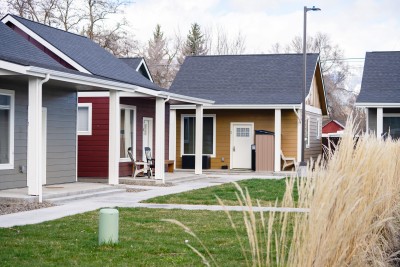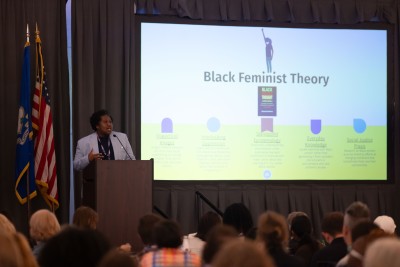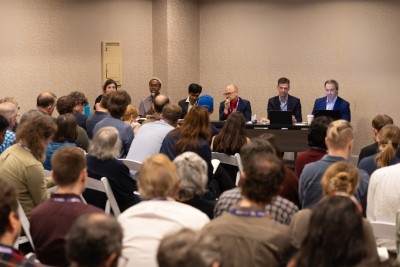By Mary Kyle McCurdy and Jacky Lee | 3-minute read
The people of YIMBYtown enthusiastically say YES: yes to new homes, yes to public transit, and yes in my back yard! Our team attended the 2025 YIMBYtown in New Haven, Connecticut to build connections with pro-homes and pro-transit organizations around the country, share what Oregon has accomplished, and learn about new pathways for addressing Oregonians’ housing and transit needs.
Here are our top seven takeaways from YIMBYtown:
Where, what, and how we build is critically important
We are not meeting people’s housing needs if we don’t build the right supply in the right location. Keynote speaker and chief economist at Redfin Daryl Fairweather (banner image) emphasized the centrality of climate resiliency in building housing. This means being thoughtful about what we build, where we build it, how we build, and how we will ensure it going forward.
Compact communities with more dense housing and walkable neighborhoods located away from areas of higher risk from wildfires, floods, and other disasters decrease climate impact and increase economic and environmental prosperity for all. Oregon’s land use system, especially our Urban Growth Boundaries, have already been very effective at preventing development in the most disaster-prone areas of the state, but we must continue to adapt our policy to changing climate conditions to keep people's lives and livelihoods from being upended.

Housing supply is crucial
This conference underscored the ongoing importance of increasing housing supply as a means to improving affordability and access. Our housing market is shaped by decades of underinvestment in new homes, especially smaller homes that are more affordable to rent or buy. The market has also been shaped by decades of racist redlining policies, which have intentionally excluded people of color from high-opportunity neighborhoods.
We need to work together across all sectors to substantially increase home diversity and supply in all neighborhoods—while making sure to preserve existing affordable homes. We need to design thoughtful development policies that prevent gentrification and undo segregation, while ensuring everyone has the choice to live where they want to. That may seem like a lot of lofty goals, but as many people at this conference would agree, it is possible to achieve all of these outcomes.
“Pro homes” is not the same as “pro housing”
Many people in the YIMBY movement are making a rhetorical and cultural shift from “pro housing” to “pro homes.” This means that we’re not just fighting for the bare minimum of housing; we’re fighting for places where people in our communities truly feel at home and can thrive.
This means actual affordability, true accessibility, and resilient communities. It means integrating transit, food systems, and community spaces into our neighborhoods. It means attending to people’s need for autonomy and self-determination within their homes and communities.
And it means ensuring that families and communities are not vulnerable to displacement—either economic or environmental — and that we build greater stability and resilience for generations to come.

YIMBY is a very diverse movement
One thing that struck us most about this conference was the diversity of opinions, priorities, and backgrounds represented. Landlords, tenants, developers, government officials, and activists all united under the umbrella of saying yes to homes, but that doesn’t mean we all agree on what we want to see or how we want to get there. Ideologies varied from people that championed social housing and sweeping rent control policies to those who support complete government deregulation and private property rights. This is an ongoing conversation, with a lot that 1000 Friends can learn and a lot we can contribute.
Oregon is not alone in its transportation troubles
The Oregon Legislature’s failure to pass the transportation package is unfortunately not unique. States and cities around the country have been struggling to pass, fund, and build new public transit and active transportation projects, while highway infrastructure continues to be prioritized.
Speakers at YIMBYtown called on us to consider: How can we re-orient our transportation advocacy to meet the everyday needs of people? Thirty percent of Oregonians and approximately thirty percent of Americans do not or cannot drive. Many others wish they did not have to drive as often or as far. Yet, we have overwhelmingly designed a transportation system to move cars, not people.

Oregon is ahead of the game on legalizing housing… but what comes next?
Many states and cities are still fighting to legalize ADUs, duplexes, triplexes, and other housing types that Oregon cities legalized nearly six years ago. Our state continues to be an example for other communities who are looking to legalize middle housing, reform parking mandates and minimum lot sizes, and build more housing without compromising their land use priorities.
At the same time, we found ourselves asking: Now that we’ve legalized housing in Oregon, what’s next? We learned about creative pathways for funding housing, ways to improve and simplify permitting processes, and ways to eliminate problematic incentives in the building and housing market.
There’s a lot we can learn from other communities’ innovations
Many other communities around the country have won big reforms, which we might be able to replicate in Oregon!We heard from residents of Montana, who lobbied for a building code amendment to allow single-stair apartment buildings, decreasing the cost of construction. We spoke with tenant organizers in Connecticut, who shared how they have been able to mobilize tenants to collectively bargain with their landlords for better rents, rights, and protections, as well as advocates in Seattle who shared about a massive investment in social housing passed this year, funded by a payroll tax on top earning executives. We also heard from the governor of North Dakota, who emphasized how their State Public Bank—created in 1919—has enabled them to more effectively invest in public infrastructure and new housing. And we learned about Pennsylvania’s Land Value Tax, an alternative property tax system, which has been in place for nearly 30 years, and has shaped its cities and towns for greater vitality and affordability.
We’re taking all this knowledge and connections back to Oregon, so we can prioritize working on policies that will benefit all Oregonians.
Do you believe in this vision? Learn more about 1000 Friends of Oregon’s policy work around building great communities.
